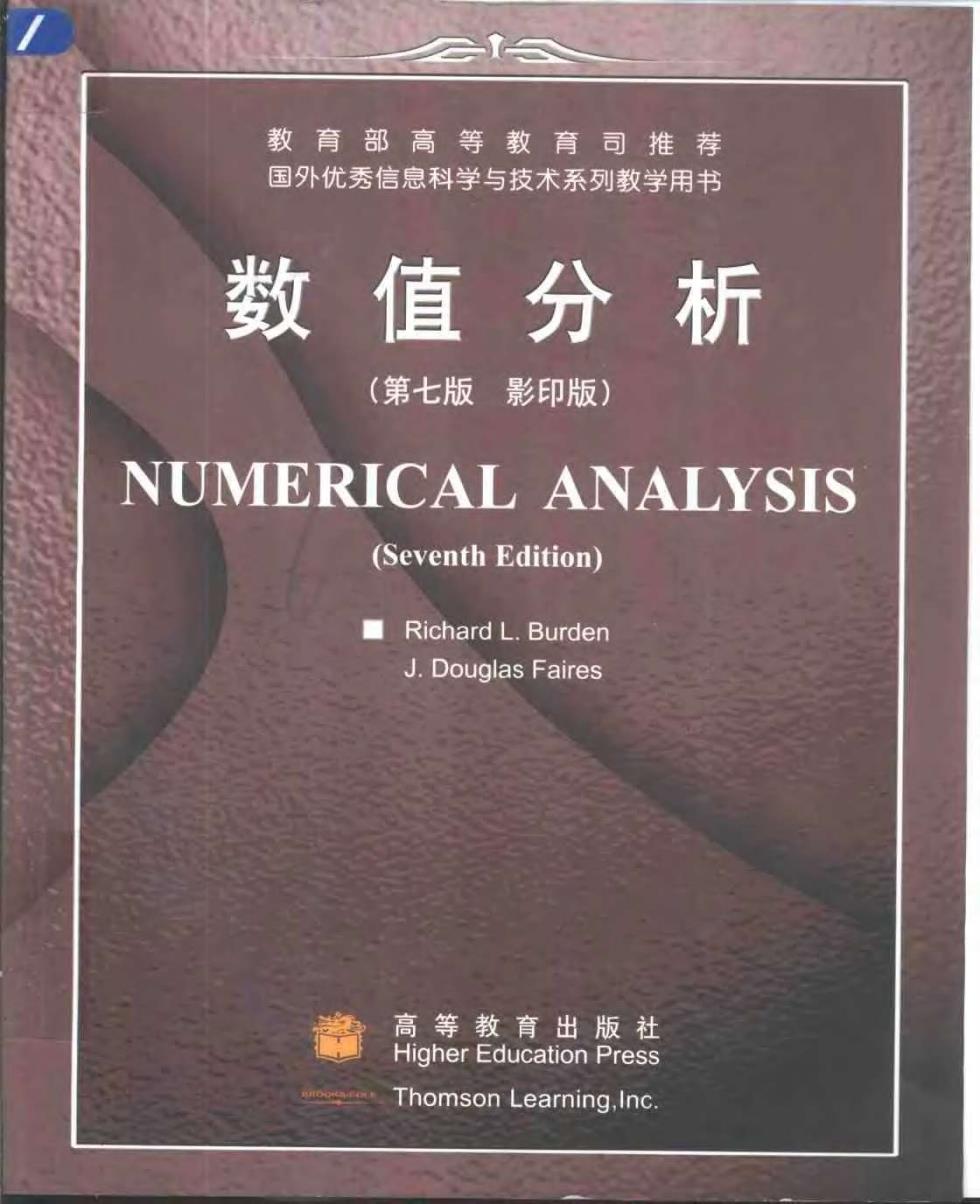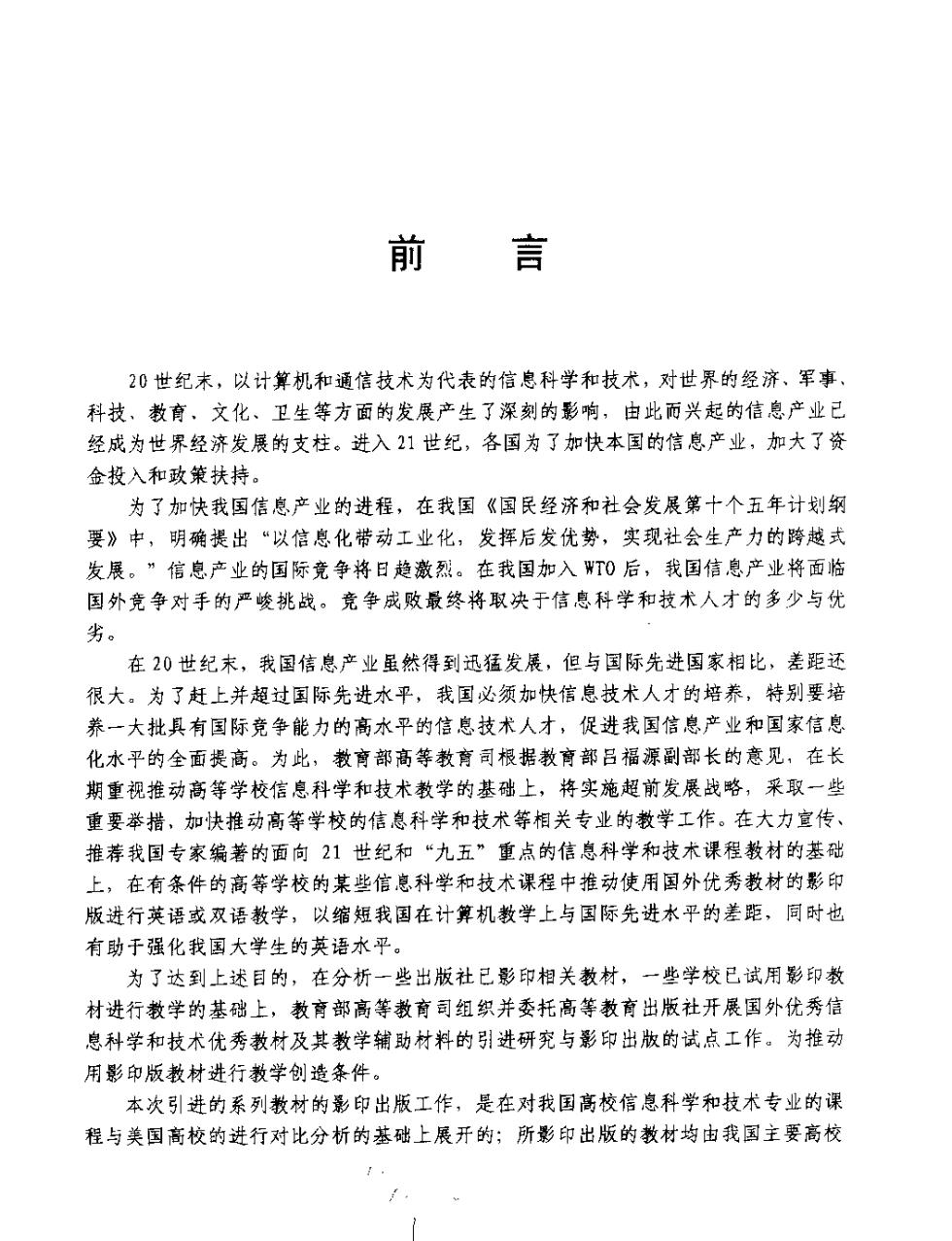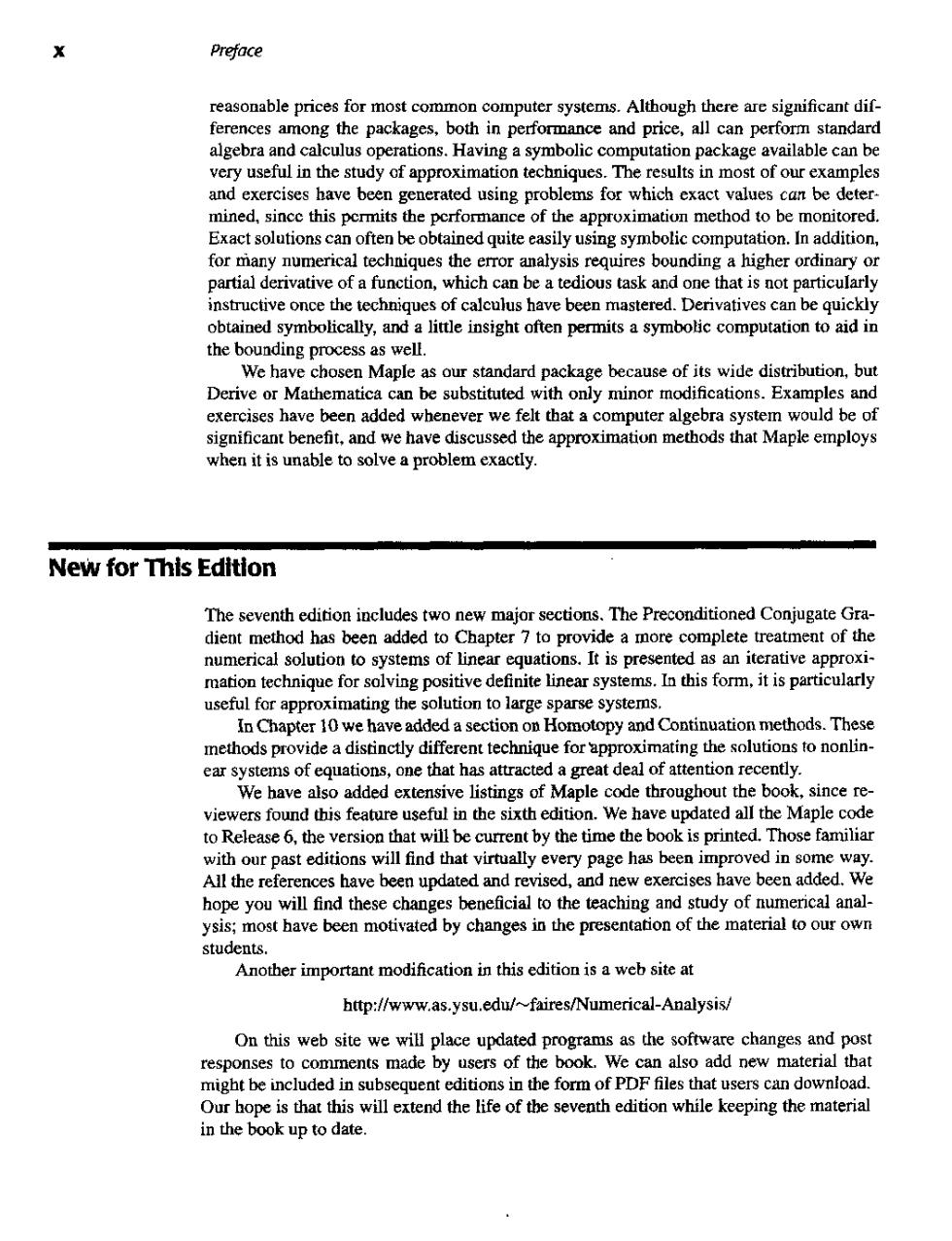
教育部高等教育司推荐 国外优秀信息科学与技术系列教学用书 数值分析 (第七版影印版) NUMERICAL ANALYSIS (Seventh Edition) ■Richard L.Burden J.Douglas Faires 高等教育出版社 Higher Education Press Thomson Learning,Inc

前 言 20世纪未,以计算机和通信技术为代表的信息科学和技术,对世界的经济、军事、 科技、教育、文化、卫生等方面的发展产生了深刻的影响,由此而兴起的信息产业己 经成为世界经济发展的支柱。进入21世纪,各国为了加快本国的信息产业,加大了资 金投入和政策扶持。 为了加快我国信息产业的进程,在我国《国民经济和社会发展第十个五年计划纲 要》中,明确提出“以信息化带动工业化,发挥后发优势,实现社会生产力的跨越式 发展。”信息产业的国际竟争将日趋藏烈。在我国加入WT0后,我国信息产业将面临 国外竞争对手的严峻挑战。竞争成败最终将取决于信息科学和技术人才的多少与优 劣。 在20世纪末,我国信息产业虽然得到迅猛发展,但与国际先进国家相比,差距还 很大。为了赶上并超过国际先进水平,我国必须加快信息技术人才的培养,特别要培 养一大批具有国际竞争能力的高水平的信息技术人才,促进我国信息产业和国家信息 化水平的全面提商。为此,教商部高等教育司根据教商部吕福源副部长的意见,在长 期重视推动高等学校信息科学和技术教学的基础上,将实施超前发展战略,采取一些 重要举措,加快推动高等学校的信息科学和技术等相关专业的教学工作。在大力宣传、 推荐我国专家编著的面向21世纪和“九五”重点的信息科学和技术课程教材的基础 上,在有条件的高等学校的某些信息科学和技术课程中推动使用国外优秀教材的影印 版进行英语或双语教学,以缩短我国在计算机教学上与国际先进水平的差距,同时也 有助于强化我国大学生的英语水平。 为了达到上述目的,在分析一些出版社已影印相关教材,一些学校已试用影印教 材进行教学的基础上,教育部高等教育司组织并委托高等教育出版社开展国外优秀信 息科学和技术优秀教材及其教学辅助材料的引进研究与影印出散的试点工作。为推动 用影印版教材进行教学创造条件。 本次引进的系列教材的影印出版工作,是在对我国高校信息科学和技术专业的课 程与美国高校的进行对比分析的基础上展开的;所影印出版的教材均由我国主要高校

的信息科学和技术专家组成的专家组,从国外近两年出版的大量最新教材中精心筛选 评审通过的内容新、有影响的优秀教材;影印教材的定价原则二应与我国大学教材价 格相当。 教育部高等教育司将此影印系列教材推荐给高等学校,希望有关教师选用,使用 后有什么意见和建议请及时反馈。也希望有条件的出版社,根据影印教材的要求,积 极参加此项工作,以便引进更多、更新、更好的外国教材和教学辅助材料。 同时,感谢国外有关出版公司对此项引进工作的配合,欢迎更多的国外公司关心 并参与此项工作。 教育部高等教育司 二00一年四月

Preface About the Text We have developed this material for a sequence of courses on the theory and application of numerical approximation techniques.The text is designed primarily for junior-level math- ematics,science,and engineering majors who have completed at least the first year of the standard college calculus sequence.Familiarity with the fundamentals of matrix algebra and differential equations is also useful,but adequate introductory matcrial on these topics is prese ented in the text so thal those cours ed not be prerequi isites Previo In some cases.the m techniques was emphasized rather than the methods themselves;in others,the emphasis was reversed.The book has also been used as the core reference for courses at the beginning graduate level in engineering and computer science programs,and in first-year courses in introductory analysis offered at international universities.We have tried to adapt the book to fit these diverse users without compromising our original purpose: ean introduction to modern upproximation techniques. y ca sis for future studyof numerical analysis and scientific computing. The book contains sufficient material for a full year of study,but we expect many readers to use the text only for a single-term course.In such a coursc.students learn to identify the types of problems that require numerical techniques for their solution and see examples of the error propagation that can occur when numerical methods are applied. They accurately approximate the solutions of problems that cannot be solved exactly and lear techniques for estimatingeo bounds for the approximations.The remaindcr of the ext serve ce for ethods that are not c onsidered in the coursc.Either the atme ns of the ed b and edition contains more than 2 es ranging fron ntary appl and algorithms to generalizations and extensions of the theory.n addition the exercis sets include many applied problems from diverse areas of engineering,as well as from the physical,computer,biological,and social sciences.The applications chosen demonstrate concisely how numerical methods can be,and often must be.applied in real-life situations. A number of software packages have been developed to produce symbolic mathemat- domamong them in the academic envirmt are Derive matica Student ve ersions of these software packages are available at

Preface reasonable prices for most common computer systems.Although there are significant dif- ferences among the packages,both in performance and price,all can perform standard algebra and calculus operations.Having a symbolic computation package available can be very useful in the study of approximation techniques.The results in most of our examples and exercises have been g rated using problems for which exact values can be dete mined since this nits the metbod to he Exact solution 06 ed qute easily ng symbolic tion.n chniques the error analysis requires bounding a higher ordinar partial derivative of a function,which can be a tedious task and one that is not particularly instructive once the techniques of calculus have been mastered.Derivatives can be quickly obtained symbolically,and a little insight often permits a symbolic computation to aid in the bounding process as well. We have chosen Maple as our standard package because of its wide distribution,but Derive or mathematica can be substituted with only minor modifications.Examples and ercises have been added whene ver we felt that a comp uter algebra systemn would be of ant benefit,and we have cussed the approxima ion methods that Maple employs when it is ur eto solve a problem exactly. New for This Edltion The seventh edition includes two new major sections.The Preconditioned Conjugate Gra- dien pter 7 to provide a more complete treatm ent of the nu to systems of line sIt is pre esented as an ite ative s.In this form appr ma ite linear system rly useful for approximating the solution to large sparse systems In Chapter 10 we have added a section on Homotopy and Continuation methods.The s methods provide a distinctly different technique for approximating the solutions to nonlin ear systems of equations,one that has attracted a great deal of attention recently. We have also added extensive listings of Maple code throughout the book,since re viewers found this feature useful in the sixth edition.We have updated all the Maple code to Release 6.the version that will be current by the time the book is printed.Those familiar ith ast editi will find that virtu ally e ery roved in some way ve be ew ex he hope you will find these changes beneficial to the teaching a ysis;most have been motivated by changes in the presentation of the material to our own students. Another important modification in this edition is a web site at http://www.as.ysu.edu/~faires/Numerical-Analysis/ On this web site we will place updated programs s as the softwa responses to comments made by users of the book.We can th might be included in subsequent editions in the form of PDF files that users can download Our hope is that this will extend the life of the seventh edition while keeping the material in the book up to date